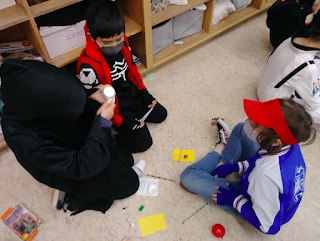Fractions & Decimals
 |
| "One, two three..flip!" Students are looking at the board where we have magnetic fraction strips set up to check which is larger |
Math: I can demonstrate the relationship between fractions and decimals; I can compare fractions.
To finish up the year in Math, we are exploring fractions and decimals. We've represented fractions as pictures (either as parts of a whole or parts of a set), and we've found equivalent fractions (ex: 1/2 is equal to 2/4). We've also practiced reading and writing fractions, using words, such as (4/5 is "four fifths").
Grade 4's have practiced comparing fractions with either the same numerator (ex: 1/5 < 1/4) or the same denominator (1/5 < 3/5). They enjoyed a game where I challenged them with really large numbers into the thousands. They found a trick to look at the denominator and think: Are the pieces the same size? Which will have bigger pieces?
Grade 5's worked on finding equivalent fractions. They quickly discovered that they can multiply the numerator and denominator by the same amount to find an equivalent fraction (ex: 2/5 = 4/10 : each is multiplied by 2). They then used this knowledge to compare fractions with different denominators to see which was larger (ex: when comparing 2/6 and 1/9, you can find a common denominator of 18 to make it easier to compare them).
In the picture above, students are playing a game with dominoes. Each student flips over a domino. Whomever has the larger amount, gets to keep the dominoes (sort of like the card game, War). If the fractions are equivalent, you each keep your own domino.
For the last week of school, we will explore decimal numbers to the hundredths place (Grade 4) or thousandths place (Grade 5).
If you're looking for a way to practice at home, both working with money and baking are great extensions!


